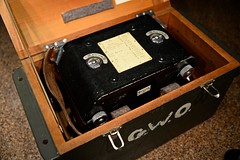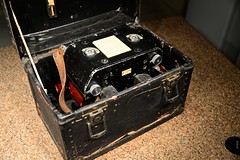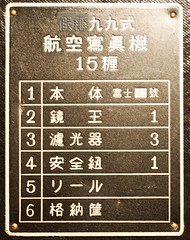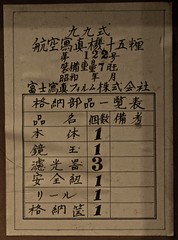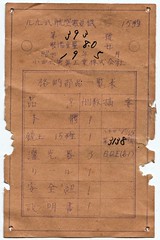|
|
| Line 46: |
Line 46: |
| | </center> | | </center> |
| | | | |
| − | = Navy Type 99 Handheld Aerial Camera =
| |
| − | {{Flickr_image
| |
| − | |image_source= http://www.flickr.com/photos/heritagefutures/5181013247/in/pool-camerawiki
| |
| − | |image= http://farm6.static.flickr.com/4151/5181013247_14cb92eb9e.jpg
| |
| − | |image_align= right
| |
| − | |image_text= Navy Type 99 Handheld Aerial Camera
| |
| − | |image_by= Dirk HR Spennemann
| |
| − | |image_rights= with permission
| |
| − | }}
| |
| − | The '''Type 99 Handheld Aerial Camera (15cm)''' (九九式航空写真機十五糎) was produced for the Japanese Navy by [[Konica|Rokuoh-sha]]( (六桜社) ) / [[Konica|Konishiroku]]) (小西六) and also by [[Fuji|Fuji Shashin Film]] (富士寫眞フィルム株式會社)<REF name="JNP p8"><i>Japanese Naval Photography</i>. Compiled by Lt W.D.Hedden, USNR, with LtCdr G.Z.Dimitroff USNR and Lt(jg) W.A. Seymour, USNR. Intelligence Targets Japan (DNI) of 4 September 1945. Facicle A-1, Target A-39. U.S. Naval Technical Mission to Japan. December 1945. pp.8-9.</REF><REF>See also the examples depicted in this article.</ref> As was usual practice with the Japanese military ordnance of the time, the name "type 99" stands for year 2599 in the Japanese imperial calendar, i.e. 1939, and signals the year the Japanese military issued the type specification.
| |
| | | | |
| − | The total number of cameras produced is unknown at this point in time. A report from the U.S. Naval Technical Mission to Japan, written in December 1945, gives detailed production figures, they refer to the Konishiroku-built Navy Type 99 Handheld Aerial Cameras only (Table 1). The total production was higher, as the numbers of cameras made by [[Fuji]] are unknown. A Japanese source claims that the introduction of the camera was plagued with reliability problems, and it only went in full service around 1943.<REF name="Wetwing Aerial"> [http://www.wetwing.com/aerialcamera/aerialcameras/cameras.html Aerial camera types] at Wetwing Aerial Camera.</REF> This seems to be borne out by the statistics provided in the U.S. report that show that production started in 1942 and was ramped up in 1943, peaking in 1944. The dramatic drop of actual deliveries compared or orders in 1945 shows the impact of the Allied bombing on specialised camera production.
| |
| | | | |
| − | <center>
| |
| − | <b>Table 1 Production volume of Navy Type 99 Handheld Aerial Cameras for the period 1941-1945</b><REF name="JNP p8" />
| |
| − | {| border="1" cellpadding="4" style="margin: 0.5em 2em; text-align: center; border-collapse: collapse;"
| |
| − | || Year || 1941 || 1942 || 1943 || 1944 || 1945 || Total
| |
| − | |-
| |
| − | || Ordered || _ || 50 || 700 || 1416 || 1440 || 3606
| |
| − | |-
| |
| − | || Delivered || _ || 50 || 600 || 1231 || 65 || 1946
| |
| − | |}
| |
| − | </center>
| |
| − | The camera is loaded with 9cm wide<REF name="JNP p8" /> perforated film rolls. The picture format is about 7.5×10cm.<REF name="Iwama"> Iwama Tomohisa (岩間倶久). "Konica history 8. Konishiroku no gun'yō kamera." (Konica history 8. 小西六の軍用カメラ. Konishiroku military cameras.) Kamera Rebyū: Kurashikku Kamera Senka (カメラレビュー クラシックカメラ専科) / Camera Review: All about Historical Cameras no.10, September 1987. No ISBN number. Konishiroku kamera no rekishi (小西六カメラの歴史, special issue on Konishiroku). Pp.54–5.</ref><ref>[http://www.wetwing.com/aerialcamera/aerialcameras/cameras.html this page] at Wetwing Aerial Camera, and ''Japanese Naval Photography'', p.11, all say 7.5×10cm. [http://www.geocities.jp/kyo_oomiya/99cam.html This page] at Kore Nāni says 70×100mm, and {{SUG}}, item 6010, says 72×98mm. </REF> The film strips are 2.3 metres in length,<REF name="JNP p8" /><REF name="JNP p18"> ''Japanese Naval Photography'', p.18.</REF> allowing for 20 exposures.<REF>The camera pictured in [http://www.geocities.jp/kyo_oomiya/99cam.html this page] at Kore Nāni clearly shows an exposure counter graduated from 1 to 20. ''Japanese Naval Photography'' * p.11) also mentions 20 exposures. [http://www.wetwing.com/aerialcamera/aerialcameras/cameras.html This page] at Wetwing Aerial Camera, mentions 6 or 10-exposure film strips, perhaps by mistake. {{SUG}}, item 6010, says that the camera takes glass plates and sheetfilm, but this is obviously a mistake. </REF>
| |
| − |
| |
| − | The camera has a folding, self-erecting frame finder at the top, and wooden handles on both sides of the body. The shutter is of the focal-plane type, with horizontally running curtains. It normally gives 1/75, 1/150, 1/250 and 1/400 speeds,<REF> [http://www.geocities.jp/kyo_oomiya/99cam.html This page] at Kore Nāni, and specifications in {{SUG}}, item 6010. </REF> selected by a wheel at the top. <REF>The American report mentions 1/25 to 1/500 speeds, probably by mistake: 'Japanese Naval Photography' (''op. cit.''), p.11. </REF> The aperture selection occurs by twisting the front section of the lens cone, copied from the mechanism of the Rokuoh Sha-bult [[Japanese_aerial_cameras#Navy Handheld Aerial Camera 25cm F-8 type | Navy Handheld Aerial Camera 25cm F-8 type]], which in tun was a copy of the [[Fairchild F-8]].
| |
| − | The main release has the shape of a trigger, actioned by the right index.<ref> See this [http://www.flickr.com/photos/heritagefutures/7582874642 image].</ref> The film is advanced and the shutter is wound by turning the right-hand handle by 90 degrees twice.<REF> [http://www.geocities.jp/kyo_oomiya/99cam.html This page] at Kore Nāni. </REF><REF name="Wetwing Aerial" /> The camera has an automatic exposure counter. The back is fully removable and is locked by two keys, with open (開) and close (閉) indications.
| |
| − |
| |
| − | At least two versions were made, reputedly one for aerial use only and the other for both aerial and terrestrial use.<REF name="Wetwing Aerial" /> The American report mentions two variants distinguished by the lens maximal aperture, either f/3.5 or f/4.5, saying that the latter was more common as the faster lens did not provide advantages that warranted the higher cost of production.<REF name="JNP p10"> 'Japanese Naval Photography' (''op. cit.''), p.10.</REF>
| |
| − |
| |
| − | ==Surviving Examples==
| |
| − | A number of examples have appeared in recent years, which allow the identification of two types (Rokuoh Sha and Fuji) and some variants among the former.<REF>Examples pictured [http://www.flickr.com/photos/heritagefutures/collections/72157630579330826/ in these image sets], as well as in [http://www.geocities.jp/kyo_oomiya/99cam.html this page] at Kore Nāni, in [http://www.wetwing.com/aerialcamera/aerialcameras/cameras.html this page] at Wetwing Aerial Camera, in {{SUG}}, item 6010, and in Iwama, p.54 of {{KKS}} no.10. </REF> The distinguishing criteria between the two types are [[Navy Type 99 Aerial Camera Distinguishing Characteristics | set out on this seperate page]].
| |
| − | At this point, it is not clear which company designed the camera. It is probable that the design originated by [[Konica|Rokuoh Sha / Konishiroku]] which had designed and manufactured several other cameras for the Japanese military. On the other hand, the top line of the contents list attached to the inside lid of the transport case of the Fuji-built unit sn#62 reads " 假稱" 九九式 (kashō 99-shiki; temporary designation Type 99), with the first two characters of the aluminium tag blackened out.<ref>[http://www.flickr.com/photos/heritagefutures/7567103848/ see this image]. Transliteration and translation by [[User:Rebollo_fr]].</ref> Given the reputed reliability problems which delayed the introduction into service,<REF name="Wetwing Aerial"/> it is quite possible that the early models testing models entering limited service before they were formally approved.
| |
| − |
| |
| − |
| |
| − | ===Cameras manufactured by Rokuoh Sha / Konishiroku===
| |
| − |
| |
| − | The front cone is attached to the camera with four visible screws. It has four ratchet stops machined into the fore edge, even if only a three-aperture setting lens was fitted.<ref>[http://www.flickr.com/photos/heritagefutures/7582256540 See this image]</ref> The shutter advance grip on the right has a vertically ribbed, oval-shaped metal plate the front and a straight band on the back. The bottom bracket holding the grip protrudes from the camera body at an angle and with a visible step. The thumb push-button to release the film-advance lock is curved with broad grooves. The finger surface of the shutter release shows wide grooves (8 grooves/10mm).
| |
| − |
| |
| − | ''Top plate'': The shutter speed selector sits off centric on a raised oval-shaped base. The shutter speed is set by lifting the entire mushroom-shaped knob with a thin top. The self-erecting viewfinder protrudes slightly from the front plate and has a front wire frame with an round cross-section (dimensions: front frame 2 1/8" x 1 3/4", back frame 1 1/4" x 1 1/2").<ref>It is intriguing that the design seems to have been made in Imperial rather than Metric. All measurements work out in inches .</ref> The film counter is more or less in line with the left hand grip of the camera, with the varying positions of the round counter window.
| |
| − |
| |
| − | ''Bottom plate'': The locks for the film spools show an aluminium knob with a central crew. In the center of the bottom plate is the serial number tag (aluminium or Bakelite).
| |
| − |
| |
| − | ''Removable back'': The Bakelite note slate on the removable back is more high than wide (3" x 2 3/8").
| |
| − |
| |
| − | Over time, some modifications occurred.<ref>At present it is not clear to what extent these variations are the result of different workshops/plants. The previously cited U.S. Naval Technical Mission to Japan reported that Konishiroku manufactured its aerial cameras at its Yodabashi and Hanno plants (both Tokyo)(''Japanese Naval Photography'', p.8).—Some changes, such as the shift from Aluminium to Bakelite tags is likely the result of cost saving measures in the face of material shortages.</ref> An inspection of a range of examples has shown the existence of at least two major variants which can be distinguished based on the film counter mechanism:<ref>Note that the naming of the variants is arbitrary.</ref>
| |
| − |
| |
| − | ====Variant A====
| |
| − | The film counter window is flush with the top plate and located towards the back of the camera.
| |
| − |
| |
| − | '''Variant A1 (early):''' The camera has a serial number tag made from aluminium (punched unit stamp,<ref>Rarely present.</ref> Rokuoh-Sha/Konishuroku Symbol, punched naval anchor<ref>Occasionally absent.</ref> | punched serial number). The removable backs have the fasteners for the pressure plate shown on the outside of the back as four raised circles, each with a raised central dome.<ref>Both criteria documented for serial numbers: #344.</ref>.
| |
| − |
| |
| − | '''Variant A2 (late):''' The camera has a serial number tag made from white [[Bakelite]] (engraved unit stamp,<ref>Rarely present.</ref> Rokuoh-Sha/Konishuroku Symbol, engraved naval anchor<ref>Occasionally absent.</ref> | engraved serial number).<Ref>Documented for serial numbers: #393, #566, #813, #819, #844, #1009, #1185.</ref> The earlier removable backs have the fasteners for the pressure plate shown on the outside of the back as four raised circles, each with a raised central dome,<ref>Documented for serial numbers: ##393, #566, #593.</ref> while the later backs lack the raised central domes.<Ref>Documented for serial numbers: #813, #819, #844, #849, #1009, #1117, #1184.</ref>
| |
| − | Note that there is no discernible serial number pattern whether the tags with the closing directions are made from aluminium or from [[Bakelite]].<ref>Given the raw material shortages experienced by Japan in the later stages of World War II it is possible that what appears to be [[Bakelite]] are in fact tags made from bone. Close inspection of the [http://www.flickr.com/photos/heritagefutures/7581791254 tags] shows that they are cut, rather than molded and that they seem to have straitios in the material, which would suggest bone as the raw material.</ref>
| |
| − |
| |
| − | ====Variant B ====
| |
| − | The film counter window is located on a well-defined circular area plate slightly raised off the top plate, with the window located towards the front of the camera.<ref>As the overall position of the center of the exposure number wheel has not changed compared to Variant A, it is possible that top plate above the exposure number wheel was raised to allow for better movement.</ref> The camera has a serial number tag made from white [[Bakelite]] (engraved unit stamp,<ref>Occasionally absent.</ref> Rokuoh-Sha/Konishuroku Symbol, engraved naval anchor<ref>Occasionally absent.</ref> | engraved serial number).<Ref>Documented for serial numbers: #1257.</ref>
| |
| − |
| |
| − | ====Documented Lens Options====
| |
| − | The lens is attached to the camera through a mounting flange held by by four screws. It has the standard three prongs at the front for filter attachment. The aperture ring is fitted with a two-pronged lever tab that is connected to the inner sleeve of the lens cone. Aperture is set by turning the end of the inner sleeve which protrudes from the outer lens cone.<ref>This is a direct copy of the mechanism used in the [[Fairchild F-8]] and its Japanese copy, the Rokuoh Sha-bult [[Japanese_aerial_cameras#Navy Handheld Aerial Camera 25cm F-8 type | Navy Handheld Aerial Camera 25cm F-8 type]].</ref>
| |
| − |
| |
| − | Documented are the following three lens options:
| |
| − | * Hexar Ser. II B 1:3.5 f=15cm Rokuoh-sha Tokyo Nº xxxx <ref>On record are Hexar sn#3223 (possibly body #150 based on number painted on the packing case).</ref>
| |
| − | * Hexar Ser. I B 1:4.5 f=15cm Konishiroku Tokyo Nº xxxx <ref>On record are Hexar sn#3050 (body #344)(lettering 'Konishiroku' in [http://www.flickr.com/photos/heritagefutures/7581955156 very messy alignment]); Hexar #3910 (body #1009)</ref><REF>See also example pictured in [http://www.geocities.jp/kyo_oomiya/99cam.html this page] at Kore Nāni. </REF>
| |
| − | * Hexar Ser. I B 1:4.5 f=15cm xxxx<ref>On record are Hexar sn#4152 (on body #1185); Hexar #4098 (on body #1257);</ref>
| |
| − |
| |
| − |
| |
| − | {|class=plainlinks align=center
| |
| − | ||
| |
| − | {{Flickr_image
| |
| − | |image_source= http://www.flickr.com/photos/heritagefutures/7582125118/in/pool-camerawiki
| |
| − | |image= http://farm6.static.flickr.com/8010/7582125118_3e7fe29e2a_m.jpg
| |
| − | |image_align= center
| |
| − | |image_text=
| |
| − | |image_by=
| |
| − | |image_rights=
| |
| − | }}
| |
| − | ||
| |
| − | {{Flickr_image
| |
| − | |image_source= http://www.flickr.com/photos/heritagefutures/7582119862/in/pool-camerawiki
| |
| − | |image= http://farm6.static.flickr.com/8154/7582119862_4fc3e6d385_m.jpg
| |
| − | |image_align= center
| |
| − | |image_text=
| |
| − | |image_by=
| |
| − | |image_rights=
| |
| − | }}
| |
| − | ||
| |
| − | {{Flickr_image
| |
| − | |image_source= http://www.flickr.com/photos/heritagefutures/7582075992/in/pool-camerawiki
| |
| − | |image= http://farm6.static.flickr.com/8020/7582075992_d2dc6d9bfa_m.jpg
| |
| − | |image_align= top
| |
| − | |image_text=
| |
| − | |image_by=
| |
| − | |image_rights=
| |
| − | }}
| |
| − | |-
| |
| − | ||
| |
| − | {{Flickr_image
| |
| − | |image_source= http://www.flickr.com/photos/heritagefutures/7582102646/in/pool-camerawiki
| |
| − | |image= http://farm6.static.flickr.com/8142/7582102646_b5c6d50480_m.jpg
| |
| − | |image_align= center
| |
| − | |image_text=
| |
| − | |image_by=
| |
| − | |image_rights=
| |
| − | }}
| |
| − | ||
| |
| − | {{Flickr_image
| |
| − | |image_source= http://www.flickr.com/photos/heritagefutures/7582083394/in/pool-camerawiki
| |
| − | |image= http://farm6.static.flickr.com/8024/7582083394_f95d2e18ab_m.jpg
| |
| − | |image_align= center
| |
| − | |image_text=
| |
| − | |image_by=
| |
| − | |image_rights=
| |
| − | }}
| |
| − | ||
| |
| − | {{Flickr_image
| |
| − | |image_source= http://www.flickr.com/photos/heritagefutures/7582068596/in/pool-camerawiki
| |
| − | |image= http://farm6.static.flickr.com/8146/7582068596_64687654aa_m.jpg
| |
| − | |image_align= top
| |
| − | |image_text=
| |
| − | |image_by=
| |
| − | |image_rights=
| |
| − | }}
| |
| − | |-
| |
| − | |colspan=3 align="center"|
| |
| − | {{Flickr_image_caption
| |
| − | |image_text= [[Konica|Rokuoh-sha]]-built Type 99 Handheld Aerial Camera (15cm)
| |
| − | |image_by= Dirk HR Spennemann
| |
| − | |image_rights= with permission
| |
| − | }}
| |
| − | |}
| |
| − |
| |
| − | ===Cameras manufactured by Fuji===
| |
| − | The front cone is attached to the camera without visible screws. The shutter advance grip on the right has a smooth oval-shaped metal plate on both the front and back. The bottom bracket holding the grip protrudes from the camera body at an angle, but without a visible step. The thumb push-button to release the film-advance lock is angular with fine grooves. The finger surface of the shutter release shows fine grooves (15 grooves/10mm).
| |
| − |
| |
| − | ''Top plate'': The shutter speed selector sits on a raised circular base. The shutter speed is set by lifting the narrow external ring of a mushroom-shaped knob with a thick top. The self-erecting viewfinder is mounted flush with the front plate and has a front wire frame with an angular cross-section (dimensions: front frame, 2" x 1 7/8", back frame 1" x 1 1/2").<ref>It is intriguing that the design seems to have been made in Imperial rather than Metric. All measurements work out in inches .</ref> The film counter with its square window is positioned to the right of the left hand grip of the camera.
| |
| − |
| |
| − | ''Bottom plate'': The locks for the film spools show an aluminium knob without a central crew. In the center of the bottom plate is the serial number tag (silver text on black background with date | punched unit stamp,<ref>Occasionally absent.</ref> serial number, punched naval anchor<ref>Occasionally absent.</ref> | Fuji Photo Film Co Ltd).
| |
| − |
| |
| − | ''Removable Back'': The surface of the back is smooth throughout without any protrusions. The [[Bakelite]] note slate is square (3" x 3"). The closing tags are made from aluminium.<ref>Unlike the backs of the Rokuoh-Sha/Konishiroku-built cameras which have engraved serial numbers (theoretically matching with those of the camera bodies), the serial numbers of the Fuji-built units are hand painted.</ref>
| |
| − |
| |
| − |
| |
| − | {|class=plainlinks align=center
| |
| − | ||
| |
| − | {{Flickr_image
| |
| − | |image_source= http://www.flickr.com/photos/heritagefutures/7567208648/in/pool-camerawiki
| |
| − | |image= http://farm6.static.flickr.com/8026/7567208648_c36279c834_m.jpg
| |
| − | |image_align= center
| |
| − | |image_text=
| |
| − | |image_by=
| |
| − | |image_rights=
| |
| − | }}
| |
| − | ||
| |
| − | {{Flickr_image
| |
| − | |image_source= http://www.flickr.com/photos/heritagefutures/7567205744/in/pool-camerawiki
| |
| − | |image= http://farm6.static.flickr.com/7253/7567205744_d260c2109e_m.jpg
| |
| − | |image_align= center
| |
| − | |image_text=
| |
| − | |image_by=
| |
| − | |image_rights=
| |
| − | }}
| |
| − | ||
| |
| − | {{Flickr_image
| |
| − | |image_source= http://www.flickr.com/photos/heritagefutures/7567185112_01cca3de37/in/pool-camerawiki
| |
| − | |image= http://farm6.static.flickr.com/8009/7567185112_01cca3de37_m.jpg
| |
| − | |image_align= center
| |
| − | |image_text=
| |
| − | |image_by=
| |
| − | |image_rights=
| |
| − | }}
| |
| − | |-
| |
| − | ||
| |
| − | {{Flickr_image
| |
| − | |image_source= http://www.flickr.com/photos/heritagefutures/7567203828/in/pool-camerawiki
| |
| − | |image= http://farm6.static.flickr.com/8145/7567203828_d3704d6142_m.jpg
| |
| − | |image_align= top
| |
| − | |image_text=
| |
| − | |image_by=
| |
| − | |image_rights=
| |
| − | }}
| |
| − | ||
| |
| − | {{Flickr_image
| |
| − | |image_source= http://www.flickr.com/photos/heritagefutures/7567189110/in/pool-camerawiki
| |
| − | |image= http://farm6.static.flickr.com/8141/7567189110_8746481d29_m.jpg
| |
| − | |image_align= center
| |
| − | |image_text=
| |
| − | |image_by=
| |
| − | |image_rights=
| |
| − | }}
| |
| − | ||
| |
| − | {{Flickr_image
| |
| − | |image_source= http://www.flickr.com/photos/heritagefutures/7567181314/in/pool-camerawiki
| |
| − | |image= http://farm6.static.flickr.com/8024/7567181314_84356953d6_m.jpg
| |
| − | |image_align= top
| |
| − | |image_text=
| |
| − | |image_by=
| |
| − | |image_rights=
| |
| − | }}
| |
| − | |-
| |
| − | |colspan=3 align="center"|
| |
| − | {{Flickr_image_caption
| |
| − | |image_text= [[Fuji|Fuji Shashin Film]]-built Type 99 Handheld Aerial Camera (15cm) (The unit is lacking its lens)
| |
| − | |image_by= Dirk HR Spennemann
| |
| − | |image_rights= with permission
| |
| − | }}
| |
| − | |}
| |
| − |
| |
| − | ==Links==
| |
| − | * [[Navy Type 99 Aerial Camera Distinguishing Characteristics | Distinguishing Characteristics of Navy Type 99 Aerial Cameras]] manufactured by Rokuoh Sha and by Fuji.
| |
| − | * [[Navy Type 99 Aerial Camera Sets | Description of Navy Type 99 Aerial Camera Storage Boxes and Packing Lists ]].
| |
| − |
| |
| − | ==Notes==
| |
| − | <references />
| |
| | | | |
| | =Navy Type 99 Aerial Camera Sets= | | =Navy Type 99 Aerial Camera Sets= |
Navy Field Camera
The Navy Field Camera (21cm & 36cm) (¶¶¶) was produced for the Japanese Navy by Rokuoh-sha( (六桜社) ) / Konishiroku) (小西六)[1]
f/4.5 21cm or 36cm , plate size 12 x 16.5 (nominally)
discuss relationship to Army camera
A report from the U.S. Naval Technical Mission to Japan, written in December 1945, gives detailed production figures (Table 1), showing that the camera was introduced in 1942.[1] The dramatic drop of actual deliveries compared or orders in 1945 shows the impact of the Allied bombing on specialised camera production.
Table 1 Production volume of Navy Field Cameras for the period 1941-1945[1]
| Year |
1941 |
1942 |
1943 |
1944 |
1945 |
Total
|
| 21cm model
|
| Ordered |
— |
150 |
150 |
300 |
300 |
900
|
| Delivered |
— |
127 |
28 |
293 |
20 |
468
|
| 36cm model
|
| Ordered |
— |
80 |
100 |
120 |
120 |
420
|
| Delivered |
— |
55 |
124 |
3 |
— |
182
|
Army Type B Field Camera
The Army Type B Field Camera (21cm) (¶¶¶) was produced for the Japanese Army by Rokuoh-sha( (六桜社) ) / Konishiroku) (小西六)[1]
discuss relationship to Navy camera
A report from the U.S. Naval Technical Mission to Japan, written in December 1945, gives detailed production figures (Table 1), showing that the camera was introduced in 1941.[1]
f/4.5 21cm , plate size 12 x 16.5 (nominally)
Table 1 Production volume of Army Type B Field Camera for the period 1941-1945[1]
| Year |
1941 |
1942 |
1943 |
1944 |
1945 |
Total
|
| Ordered |
75 |
125 |
50 |
50 |
— |
300
|
| Delivered |
50 |
100 |
— |
100 |
— |
250
|
Navy Type 99 Aerial Camera Sets
As was custom with all Japanese military camera gear, the the Type 99 Handheld Aerial Cameras (15cm) (九九式航空写真機十五糎) were supplied as a set complete with all the required paraphernalia (such as filters, additional magazines etc).
Storage Boxes
Table 1 Shape of boxes
Packaging Lists
To ensure that store personnel could account for the contents of the sets, camera manufacturers affixed content labels on the insides of the storage boxes. These labels were made of aluminum, printed paper or (cheaper) duplication by mimeograph or Whiteprint.
Table 2 Packing Labels (Lists of Contents)
Notes
- ↑ 1.0 1.1 1.2 1.3 1.4 1.5 Japanese Naval Photography. Compiled by Lt W.D.Hedden, USNR, with LtCdr G.Z.Dimitroff USNR and Lt(jg) W.A. Seymour, USNR. Intelligence Targets Japan (DNI) of 4 September 1945. Facicle A-1, Target A-39. U.S. Naval Technical Mission to Japan. December 1945. pp.8-9 Cite error: Invalid
<ref> tag; name "JNP p8" defined multiple times with different content
- ↑ The camera that came with the case is a Rokuoh-sha-built unit sn#1257, but the paper label in the lid shows that the box belonged to a Fuji Shashin Film-built unit sn#122.
- ↑ See this Wikipedia entry for the duplication technique.
- ↑ See this Wikipedia entry for the duplication technique.


